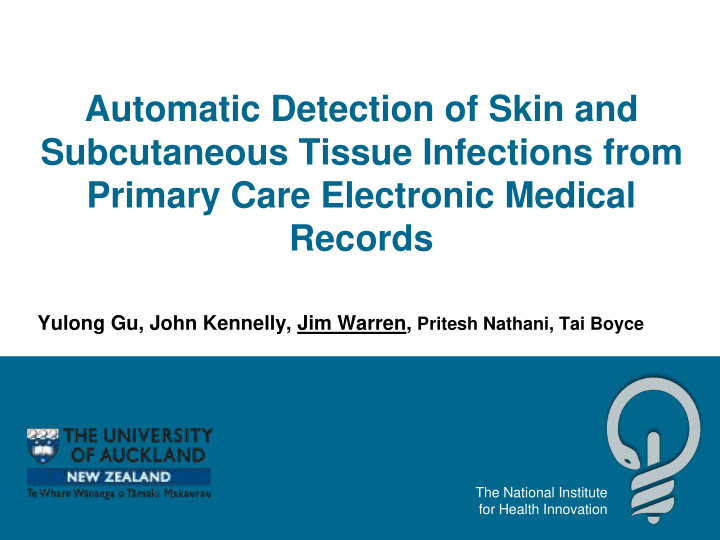



Automatic Detection of Skin and Subcutaneous Tissue Infections from Primary Care Electronic Medical Records Yulong Gu, John Kennelly, Jim Warren, Pritesh Nathani, Tai Boyce The National Institute for Health Innovation
Skin and Subcutaneous Tissue Infection (SSTI) epidemic in NZ • Infectious. • Caused by staphylococcus aureus and/or streptococcus pyogenes bacteria. • Rates from 298/100,000 in 1990 to 547/100,000 in 2007. • There are social and ethnic inequalities reported in the disease risk factors. • Antibiotics are effective in treating SSTI; but delaying treatment or non-adherence to treatment can lead to complications & hospitalizations.
Study aim and design • To explore the feasibility and performance of automatic detection of SSTI occurrences and recurrences by analyzing ambient primary care EMRs. • Four general practices in Auckland that serve large numbers of Pacific and Māori patients participated in the study.
Study data • EMR data on child and adolescent populations (age ≤ 20): – Demographic information – Laboratory testing results – Diagnoses – Notes – Prescriptions • Data range: Oct/2011 - Oct/2014
A high-level SSTI ontology
SSTI ID process • A skin swab lab test can confirm the presence of bacteria colonies on skin. • READ coded Dx: e.g., cellulitis, impetigo, subcutaneous abscess, boil, folliculitis, infected eczema. • Clinical notes may include SSTI READ / SNOMED terms and synonyms. • Exclude SSTI interpretation from notes alone if chickenpox mentioned
Findings – High SSTI rates • 3,886 ≤20 year -olds living in 1,833 households were included in the main analysis. • 1,382 (36%) from 864 house-holds (47%) had an average of two SSTI occurrences in the last three years (total SSTI occurrence number = 2,714). • SSTI occurrence rate was 230 per 1000 person-years.
Findings – SSTI treatment & recording • 91% of SSTI occurrences were treated with oral antibiotics (e.g., penicillin) or topical antibiotics (e.g., fusidic acid). • Among all identified SSTI occurrences – 22% were coded with a READ diagnosis and 16% were confirmed by skin swab tests. – Only 7% of SSTI cases didn’t have note entries associated with SSTI – 65% of SSTI cases had neither Dx nor lab records, i.e., identified by notes only.
Findings – SSTI algorithm evaluation • 1,245 casual patients (unfunded, aged ≤20) in the participating practices. A random sample of 200 of these patients was included in the evaluation. • PPV=64%, sensitivity=94%, specificity= 97%, NPV=99.6%, F 1 score=0.76. Condition Condition positive negative Test outcome positive 16 9 Test outcome negative 1 281
Study implications – SSTI Risk ID • Reliable EMR based identification of SSTIs provides a basis for: – assessing size of the problem, for funding and planning purposes, – identifying patients for follow up, – evaluating intervention effect.
Study implications – Targeted interventions • Screening • Education • Early treatment • Social / economic support to address a range of risk factors associated with infections, e.g., overcrowding. http://www.healthliteracy.org.nz/wp- content/uploads/2013/11/Skin-infections-booklet.pdf
Study implications – EMR analysis • Low levels of use of READ codes from SSTIs challenges the approach of using diagnosis alone in their identification. • Via note text mining, without checking diagnosis or laboratory results, 93% of SSTI occurrences had been identified in our study. – Suggests that diagnosis codes and laboratory results might not add as much value as expected in such analyses.
Study limitations • Small number of general practices in one metropolitan region, – We went where intuition of local practitioners was that SSTI rates are high – Findings dependent on data recording practices of relatively small group of GPs and nurses
Conclusion • It is feasible to automatically detect SSTI from the EMR data collected as part of routine primary care delivery. • There are high occurrence and recurrence rates for SSTI in population aged ≤20. • There is an opportunity to improve SSTI risk management in the community.
Acknowledgement • This study was funded by a University of Auckland School of Population Health Performance-Based Research Fund (PBRF) Distribution Seeding Grant. Further info: jim@cs.auckland.ac.nz
Recommend
More recommend